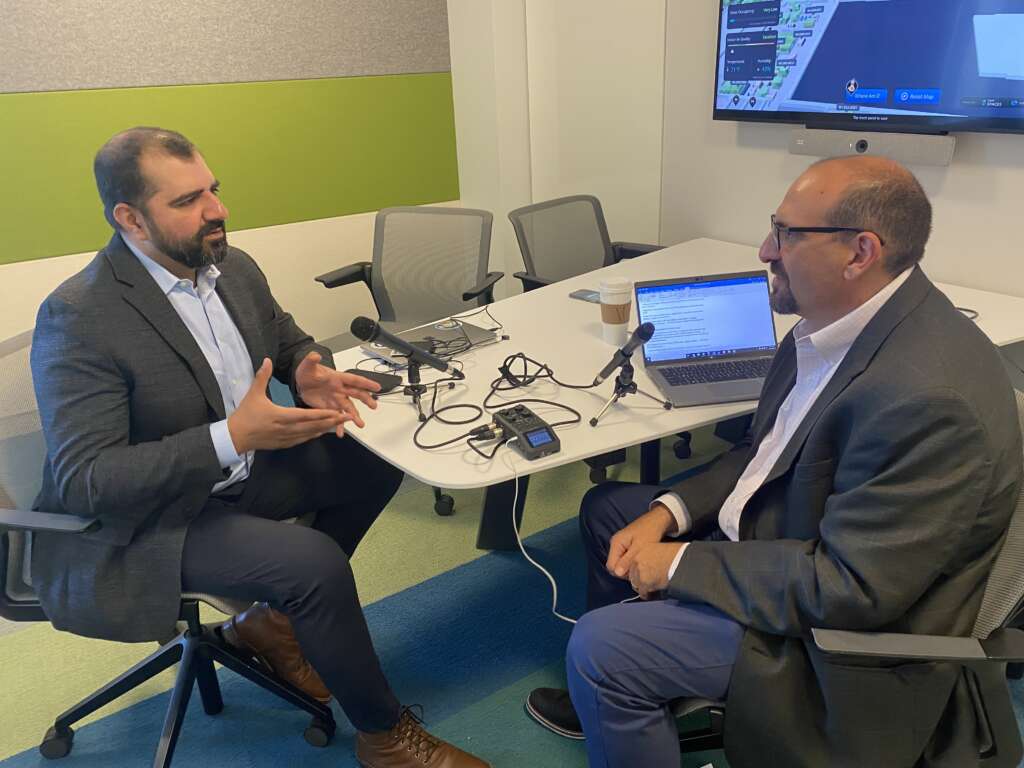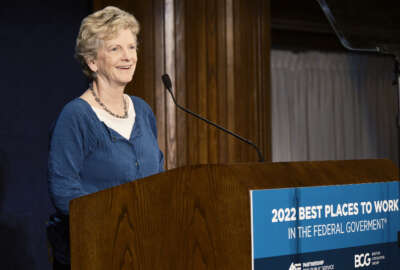Exclusive
Federal Acquisition Service’s new structure seeks to break down long-held fiefdoms
Sonny Hashmi, the commissioner of the General Services Administration’s Federal Acquisition Service, said the new organizational approach will be made up of five...
Over the last 18 months, the General Services Administration has been asking some hard questions, mostly about itself.
What does the Federal Acquisition Service need to look like? Does the current regional structure make sense anymore? A group of leaders and employees delved into a host of other questions in an attempt to design the future of FAS.
Sonny Hashmi, the commissioner of FAS, said the new path the working group has charted for the organization is entirely focused on serving agency and industry customers much differently than ever before.

“In a few weeks’ time, we’re going to be transitioning into a new organizational structure where major organizations within FAS, including the Assisted Acquisition Service (AAS) and the Office of Customer and Stakeholder Engagement (CASE) are going to be aligned to customer segments. Now we’re going to have teams that are fully aligned to a customer’s mission. That team and the customer will be working closely together and are going to be purely focused on achieving mission outcomes that our customer cares about,” Hashmi said in an exclusive interview with Federal News Network. “I’m confident that over time this is going to lead to better service delivery and access to talent and opportunities within the organization for people who are looking for the next step in their careers.”
The new FAS will no longer be separated by regions and will now be organized by teams serving their customers, whether it’s one team working with the Army, its largest one, or one team working with several smaller customers.
Hashmi said FAS employees will not change their work locations nor will they change what they do day in, day out.
“By bringing all these teams together, they’re supporting the Army as one unit. Now they can do more capacity management. They can support the mission in a broader way. And the Army will have one team that they can continue to work with for all of their mission requirements across the globe,” he said. “That’s just one example on how by bringing these teams together we’re going to be able to deliver better outcomes for our customers, but also develop better internal expertise to really understand the customer’s mission and actually do much more flexible staffing and capacity planning.”
GSA reorg plan receives good initial reviews
GSA announced the initial version of the FAS reorganization in late August and posted a blog about it on Sept. 7. Hashmi said the reorganization will officially start taking effect in October.
“We are going to have five divisions within the organization. We call them Apexes, and these five divisions will be led by executives, and I’m philosophically aligned to allowing these executives to make the best decisions in resource allocation as needed. Everybody in the organization, everybody in FAS, their performance plans, are aligned to the three North Stars and should be focused on customer mission delivery, creating a thriving marketplace and making it easy to do business with us,” he said. “These executives will be held accountable for making sure that we’re delivering for our customers, and will have the flexibility to align resources, as needed, to do so. Now, having said that, we want some stability too. Contracting officers require some long-term stability, and we can’t move contracts back and forth between different contracting officers because it requires long-term understanding of the work that is being done. All of those are tensions that have to be balanced out as you think about aligning resources to most pressing tasks.”
Reaction to the reorganization from current and former GSA executives has been overall positive.
One GSA official, who requested anonymity because they didn’t get permission to speak to the press, said the reorganization is a recognition that the current business model was outdated, inefficient and not giving customers a consistent experience.
“Each region was its own fiefdom with different procedures and processes. This is intended to standard and normalize efforts across all regions,” the official said. “Change always causes stress so there probably is a certain amount of stress when something like this gets rolled out, but FAS leadership is working hard to have listening sessions and all hands meetings so talking about how this will help relieve some stress.”
Mary Davie, a former FAS deputy commissioner and now president of Mary Davie Consulting, said the organization has been through big changes in the past and this one is no different. She said FAS must make it clear “why” the change is happening.
“Big change like this is usually hard and sometimes not always popular with people in an organization. This one is big for many people as the GSA regions have a lot of pride in their affiliation with the region, are very close knit groups, and have their own individual cultures and ways of doing things, as you would expect,” Davie said. “I’ve talked with a few regional leaders recently, and while they were initially ‘sad’ about the change to the regional structure, they all believe it is the right thing to do to best serve their federal agency customers and they are committed to making it successful.”
Davie added it’s key for FAS leadership to make sure their employees know where they will fit in the new organizational structure, who they will be working with and how their roles and responsibilities might change.
This is why FAS leadership will fine tune the changes brought on by the reorganization over the coming months or year based on employee, agency customer and industry feedback.
GSA employee communication is key
Hashmi said his team has been briefing lawmakers, union officials and other stakeholders about the changes.
“We’ve been doing a lot of internal conversations with employees at all levels, making sure that they understand the changes that are going to be affecting them, and how they’re going to be implemented. The subsequent step is continuing to increase our engagement with the industry on these changes,” he said. “Oftentimes when change like this happens, this is the outcome of some sort of a bad thing that happened. I believe that smart managers and leaders could come together and make important structural changes that are needed for the long-term viability of their organization. That’s a key business reason why we’re doing this.”
Davie said there is no doubt how important this communication will be to the success of this effort.
“What will actually change? What won’t? And over what period of time? Can industry and/or agencies expect a change the way in which they engage with FAS or how they receive services? They and will want to know if the FAS representative they’ve been working with will change — and how GSA will manage the relationship transition,” she said. “A significant strength of FAS is the relationships they create with their industry partners and agency customers. I have no doubt that FAS will be successful in this change and will be stronger and better positioned to serve their customers.”
Hashmi said he expects FAS’ new structure to help address the expected continue growth in business volume. FAS’ current business volume is approaching $90 billion a year, up $15 billion over the last two years.
“When you look at that growth and ultimately that growth ties to the mission impact that we create for our agencies, the value that we create for them and the work that we do for them. We were increasingly getting to a ceiling in the work that we could deliver. And that ceiling was in many cases determined by who we could recruit, where they had to live, what grades we could offer, what limitations in terms of the number of slots and headcounts that are assigned to different regions versus others,” he said. “So at this point, all employees at FAS have access to an organizational chart. They know exactly where they are, where they fit into that organizational chart, and all that information has been provided. We’ve held an all-FAS summit for two straight days where every employee could engage and hear directly from their chains of command executives all the way down in their management chain on how those roles are going to be changing. Those folks who are in the management and executive ranks have already been working together over the last several months to make sure that the new processes are in place. However, this is not just a documentation exercise. A lot of this is hearts and minds and so we built toolkits for supervisors where they can have access to all the information they need. They have been asked to have a one-on-one conversations with every single employee. Many of those conversations are already occurred. But again, these are not just one-time conversations. We have many opportunities between now and continuing into the next year to continue to work with our employees, which is one of the things that I’m very proud of.”
FAS started this reorganization planning about 18 months ago bringing together a team of about 50 people from across the country to “imagine the future of the organization.”
Hashmi said moving away from the geographical limiting model will be better for FAS employees, customers and industry partners.
Hashmi’s 3 metrics of success
He said there are three measures FAS will be looking at over the next year to make sure the reorganization is heading in the right direction.
“Number one, my promise is that we’re doing this for the long-term benefit of our customers, so that needs to be reflected through both in surveys in terms of the work that our CASE organization does day-to-day with our customers, we need to make sure that they’re getting better value out of this, they’re getting less friction, less confusion, more answers, more real time support that they need. We’re going to be closely monitoring that area and we’re going to be actively measuring metrics in that space,” Hashmi said. “Number two, it needs to reduce the burden for our employees and create new opportunities. One of the things that I’ve said from the very beginning is that the goal is that by going away from this geographically limiting model that we had operated under, more employees will have access to more opportunities that open up across the organization. I’m going to be looking at that, for example, in the next month alone as we’re going to be announcing hundreds of new leadership management and frontline supervisor opportunities that are going to be published. Now that everybody in GSA can participate in them, a good metric for me instead of essentially looking at who’s eligible to apply for the jobs that number has to increase tenfold. I’m certain that it will, because historically, if you’re a GS-13 and aspire to be a GS-14, you’re limited in the opportunities that might open up in your region. They may happen once in a while. Now you can apply to any GS-14 position opening up across FAS, which is going to be great.”
The third metric will be around recruitment. Hashmi said every agency, particularly in the acquisition field, faces challenges in hiring and retaining employees. While FAS has made steady progress in the last few years, Hashmi would like to see the number of acquisition workers FAS recruits increase even further.
“If you actually look at FAS within GSA, we’re the highest performing organization from a Federal Employee Viewpoint Survey (FEVS) perspective, from a customer service perspective one of the highest ones ranked in the entire federal government. That doesn’t happen automatically. That happens by design. We have great trust and relationships across the board between employees and their supervisors at all levels. In fact, that is one of the highest ranked metrics in EVS score for FAS, over 90% of the people say that they trust their supervisor and they have open communication with them. So now again, there’s exceptions here and there, but I do trust our incredible cadre of supervisors and leaders to continue to have those conversations with their teams to make sure that people are heard they’re protected,” he said. “They have clear mission outcomes. They’re doing important work, and wherever there is any exception to that I have made sure that everybody knows my personal cell phone and my email address and they contact me directly. I encourage anybody listening who may have any concerns about this reach out to me directly. I want to do it right and we want to make sure that this is something that is done on behalf of the American people and for the benefit of our customers.”
Copyright © 2025 Federal News Network. All rights reserved. This website is not intended for users located within the European Economic Area.
Jason Miller is executive editor of Federal News Network and directs news coverage on the people, policy and programs of the federal government.
Follow @jmillerWFED






